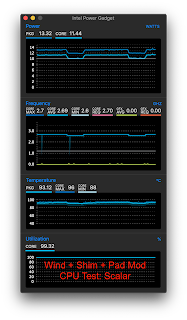MacBook Air (early 2020) configuration: i7/16GB/1TB
TL;DR: The combined modification of the wind channel, heat sink, and heat pad is reaching Apple's/Intel's hardcoded performance limits. Thermal dissipation of combined CPU and GPU load is still restricted.
Date of original mod: 17 May 2020
MacRumors: Post 1,254
I've always tried to go for low-cost reversible mods, and this one is no different. I took some tin foil and folded it multiple times to get something that was about 1 mm thick and roughly in the shape of the heat sink. I protected the edges with some clear tape and placed it on top of the heat sink.
After a 15 min stress test using Intel Power Gadget, the bottom of the case felt subjectively hotter, but the temperatures around the case were actually one or two degrees cooler than before (i.e., just the wind channel and heat sink mod).
TL;DR: The combined modification of the wind channel, heat sink, and heat pad is reaching Apple's/Intel's hardcoded performance limits. Thermal dissipation of combined CPU and GPU load is still restricted.
Date of original mod: 17 May 2020
MacRumors: Post 1,254
Heat Pad Modification
The "corrugated" heat sink design for the MacBook Air quad-core processors allows air to go through the heat sink. The foam pad that is stuck to the bottom case seems to be there to stop air from going over the heat sink; unless it's simply there to prevent the bottom case from getting too hot. The heat pad modification is three-fold: completely seal off the space above the heat sink, increase the thermal mass of the heat sink, and improve the thermal conductivity from the heat sink to the bottom case.I've always tried to go for low-cost reversible mods, and this one is no different. I took some tin foil and folded it multiple times to get something that was about 1 mm thick and roughly in the shape of the heat sink. I protected the edges with some clear tape and placed it on top of the heat sink.
Results
To evaluate the success of the combined wind channel + heat sink + heat pad modifications, I ran the tests in Intel Power Gadget 3.7.0, Geekbench 5.1.0, Cinebench R20, and Unigine Heaven 4.0. I used the same set up as before, but also waited for the CPU to cool down to around 40℃ before running the next benchmark. Each benchmark was executed at least three times and I report the average.Intel Power Gadget 3.7.0
For the CPU stress test, it stays on max turbo boost for a bit longer before dropping down. Temperatures also rise more slowly and take much longer to reach the 90℃ range. GPU temperatures are also cooler by a considerable amount. I'm quite happy with the thermal headroom. When both the CPU and GPU are stress tested together, there is about 10℃ of thermal headroom, but both seem to have been held back by some hardcoded limit.Geekbench 5
Compared to the wind channel and heat sink mod, single-core performance was marginally worse (-1.7%), and multi-core performance was better (+7%). However, graphics performance was about twice as good, although this increase does seem too good to be true and could be a Geekbench glitch on the three consecutive runs (?). Click on a "Mod" result to view the best that I got.| Test Type | Original (Points) | Mod (Points) | Improvement |
|---|---|---|---|
| CPU (Single-core) | 1,214 | 1,256 | 3.5% |
| CPU (Multi-core) | 2,992 | 3,886 | 29.9% |
| Compute (OpenCL) | 3,825 | 8,525 | 122.9% |
| Compute (Metal) | 4,285 | 9,727 | 127.0% |
(CPU test)
Cinebench R20
Compared to the wind channel and heat sink mod, performance was better for single-core (+3.5%) and multi-core (+6%). I do find it funny that Cinebench is a CPU-only benchmark, so I didn't get the high performance boost from the Compute results of Geekbench 5.| Test Type | Original (Points) | Mod (Points) | Improvement |
|---|---|---|---|
| CPU (Single-core) | 353 | 405 | 14.6% |
| CPU (Multi-core) | 979 | 1,192 | 21.8% |
| MP Ratio | 2.77 | 2.94 | 6.3% |
Unigine Heaven 4.0
I used the default custom settings (medium quality). There was a slight improvement, probably because both the CPU and GPU are being loaded, so it's because of the hardcoded limit or both are competing for the same heat sink.| Test Type | Wind + heat sink mod (Points, FPS) |
Wind + heat sink + pad mod (Points, FPS) |
Improvement |
|---|---|---|---|
| Custom/Medium | 714 | 764 | 7.0% |









